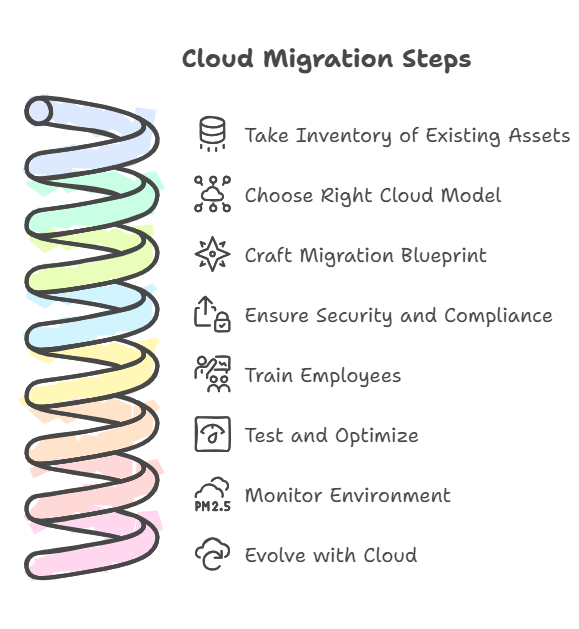Flexera 2024 State of the Cloud Report indicates that 89% of organizations are employing multi-cloud strategies, which is a slight increase from 87% in 2023. At the same time, the global cloud computing market is expected to be valued at $832.1 billion by 2025.
Growing to meet demand and staying competitive can feel impossible if you’re stuck with outdated systems. If you’re struggling with frequent outages, escalating costs, or clunky legacy applications, it’s time for a change. Why remain locked into a slow, on-premises infrastructure when scalable cloud solutions are now table stakes? In this blog, you’ll uncover the cloud migration process your small or mid-sized business can use to enhance security, speed up operations, and slash costs—without causing downtime or headaches.
As Philipp Graves, CEO, Antisyn says, “A smart cloud strategy isn’t just about moving data—it’s about unlocking new possibilities for agility and growth.”
Worried About Cloud Security Threats?
Let Antisyn’s experts safeguard your data with tailored cloud security solutions.
Why Delaying Costs You More Than Money
Postponing your move to the cloud can lead to hidden expenses like lost productivity, reduced collaboration, and missed growth opportunities. A Gartner study suggests that businesses slow to adopt cloud innovations risk losing competitive advantage in the long run. You don’t want outdated systems holding you back when rapid response times and seamless collaboration are vital to retaining customers and driving profits.
Clarify Your Destination: Defining Your Migration Goals
Begin by envisioning what you want cloud adoption to achieve. Are you aiming to cut costs, modernize applications, or improve flexibility? TechTarget’s guide to strategic cloud migration emphasizes the importance of detailed objectives. By pinpointing your purpose, you ensure that every stage of your application migration to cloud steps is aligned with tangible outcomes—like faster service delivery or new growth channels.
8 Proven Cloud Migration Steps to Future-Proof Your Business
Cloud migration enables you to move critical applications, data, and other resources from on-premises environments to the cloud. It’s not just about cutting costs—though it can certainly help there. It’s also about speeding up processes, sharpening data security, and positioning your organization for long-term innovation. By consolidating resources under one roof, you reduce complexity and open up more agility across the board. And for small and mid-sized businesses, that agility can mean the difference between thriving in a competitive market or struggling to keep up.
Among the top cloud migration steps that you need to prioritize are:
Step #1: Take Inventory of Your Existing Assets
Your first step is to analyze and catalog all applications, databases, and servers that will be affected by the move. The more comprehensive your inventory, the fewer surprises you’ll face. Mapping each asset’s resource requirements helps prioritize which workloads should migrate first—often starting with low-risk, high-value projects.
Step #2: Choose the Right Cloud Model With Caution
Picking a one-size-fits-all approach could spell trouble down the road. Public clouds like Amazon Web Services, private clouds, or hybrid models each have unique perks. If security compliance is top priority, a private or hybrid approach may be best. If budget and scalability top your list, public cloud could fit better. By understanding the trade-offs, you’ll sidestep common cloud migration pitfalls—like performance bottlenecks or unexpected expenses.
Step #3: Craft a Detailed Migration Blueprint
A solid plan outlines your steps in cloud migration from timeline to testing protocols. This includes deciding on the migration sequence of your critical applications and setting realistic milestones. Check out IBM’s cloud migration checklist for insights on designing project timelines and defining clear responsibilities. Detailed mapping reduces the risk of disruptions, keeping your team focused and confident throughout the migration.
Step #4: Don’t Skimp on Security and Compliance
Overlooking data security could be disastrous. As you move to the cloud, you need top-notch encryption and robust access controls. Many industries demand specific compliance requirements—be it HIPAA for healthcare or GDPR for businesses handling European data. Building in these safeguards from the start ensures you don’t spend extra time and resources backtracking to correct compliance gaps.
| More articles you might like: |
Step #5: Train Your People to Champion the Change
Cloud technology is only as effective as the people who use it. Prioritize hands-on training so team members feel confident with new tools and processes. Experts agree that well-trained employees adapt to new tech faster, boosting ROI. Early engagement also cuts down on resistance; when your team understands the “why,” they’re more likely to embrace the change enthusiastically.
Step #6: Test, Validate, and Optimize
Before fully migrating, run test environments to ensure each system behaves as expected. This is where you stress-test performance, functionality, and compatibility. Tools like Apache JMeter help measure application load times under real-world scenarios. Testing now prevents large-scale, after-the-fact fixes—and helps you fine-tune resource allocations for peak efficiency.
Step #7: Monitor Like a Hawk
Post-migration, watch your cloud environment closely for cost spikes or performance dips. Platforms such as Datadog or AWS CloudWatch offer real-time visibility into traffic, CPU usage, and security anomalies. Proactively resolving issues is much cheaper (and less frustrating) than waiting for them to disrupt your customers. Continuous monitoring also helps you refine resource allocations, so you only pay for what you need.
Step #8: Evolve With the Cloud
Cloud adoption is not a one-and-done event. Over time, your workloads will shift; your company might expand or pivot. Services that were once perfect might become too costly or fail to meet new compliance guidelines. Keep assessing your cloud usage to spot optimization opportunities. Remember, a well-structured cloud migration plan is a living document—always ready for growth or redirection.

Beware the Pitfalls: Common Migration Traps and How to Avoid Them
Even the most carefully planned cloud projects can go awry if you’re not prepared for common pitfalls. According to IBM’s guide on common cloud migration challenges, a few key stumbling blocks include:
- Underestimating Costs
Hidden expenses often creep in when you skip the due diligence on long-term resource usage. You might sign up for a cost-effective plan initially, only to face unexpected compute and data egress charges down the line. Make cost modeling part of your risk assessment to avoid surprise bills. - Neglecting Governance and Compliance
Overlooking security and regulatory requirements can trigger hefty fines or reputational damage. Compliance frameworks like GDPR or HIPAA demand strict protocols. Be sure you’re documenting every safeguard so you can prove compliance at any time. - Skipping Thorough Testing
Migrating workloads without adequate test runs can create performance bottlenecks that are difficult (and expensive) to fix later. Always run a pilot with key applications and user groups to validate performance under real-world conditions. - Inadequate Team Readiness
A well-designed system falls flat if your team isn’t trained to use and manage it. Ensure employees understand the new processes, tools, and best practices well ahead of your go-live date.
By tackling these concerns proactively—especially around budget forecasting, compliance, testing, and training—you’ll significantly reduce the risk of downtime, overruns, or security lapses.
Essential Steps and Considerations
| Step | Key Action | Key Consideration |
| Step #1: Asset Inventory | Catalog applications & data | Identify dependencies & resource requirements |
| Step #2: Choose Cloud Model | Select public, private, or hybrid | Factor in compliance & budget constraints |
| Step #3: Migration Blueprint | Map out timeline & responsibilities | Minimize disruptions with phased rollouts |
| Step #4: Security & Compliance | Encrypt data & manage identities | Adhere to industry-specific regulations (e.g., HIPAA) |
| Step #5: Team Training | Conduct workshops & demos | Build buy-in through clear communication & purpose |
| Step #6: Testing & Validation | Use test environments to verify apps | Ensure stability under real-world conditions |
| Step #7: Continuous Monitoring | Track performance & costs in real-time | Detect issues early with proactive alerting |
| Step #8: Ongoing Optimization | Adjust resources & revisit strategies | Scale & evolve alongside business needs |
Ignite Your Cloud Future, Partner with Antisyn Today!
Implementing these steps ensures your cloud adoption not only boosts productivity but also reduces costs and enhances security. Following a thorough plan—starting with asset inventory and ending with continuous optimization—positions you for ongoing success in a rapidly changing marketplace. Antisyn is a leading Managed Service Provider (MSP) offering tailored Cloud Solutions to help your business thrive. Ready to modernize your infrastructure and see transformative results? Contact Antisyn today for expert guidance and to schedule a personalized consultation, and take the first step toward a future-proof, cloud-empowered business.
| Award-Winning Cloud Services Near You |



